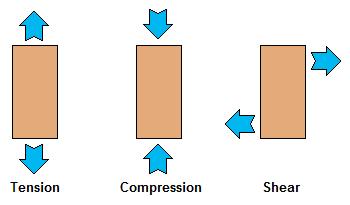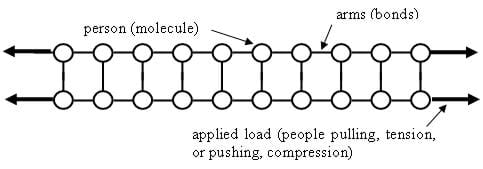Quick Look
Grade Level: 7 (6-8)
Time Required: 1 hours 45 minutes
(can be split into two 50-minute sessions)
Expendable Cost/Group: US $0.00
Group Size: 0
Activity Dependency: None
Subject Areas: Physical Science

Summary
Students conduct several simple lab activities to learn about the five fundamental load types that can act on structures: tension, compression, shear, bending and torsion. In this activity, students play the role of molecules in a beam that is subject to various loading schemes.Engineering Connection
Engineers consider many forces when planning and designing materials and structures, including tension, compression, shear, bending and torsion.
Learning Objectives
After this activity, students should be able to:
- Identify the five fundamental loads: compression, tension, shear, bending and torsion.
- Explain what is meant by something being elastic and non-elastic (inelastic).
- Describe characteristics of molecular bonds.
Educational Standards
Each TeachEngineering lesson or activity is correlated to one or more K-12 science,
technology, engineering or math (STEM) educational standards.
All 100,000+ K-12 STEM standards covered in TeachEngineering are collected, maintained and packaged by the Achievement Standards Network (ASN),
a project of D2L (www.achievementstandards.org).
In the ASN, standards are hierarchically structured: first by source; e.g., by state; within source by type; e.g., science or mathematics;
within type by subtype, then by grade, etc.
Each TeachEngineering lesson or activity is correlated to one or more K-12 science, technology, engineering or math (STEM) educational standards.
All 100,000+ K-12 STEM standards covered in TeachEngineering are collected, maintained and packaged by the Achievement Standards Network (ASN), a project of D2L (www.achievementstandards.org).
In the ASN, standards are hierarchically structured: first by source; e.g., by state; within source by type; e.g., science or mathematics; within type by subtype, then by grade, etc.
Common Core State Standards - Math
-
Understand that positive and negative numbers are used together to describe quantities having opposite directions or values (e.g., temperature above/below zero, elevation above/below sea level, credits/debits, positive/negative electric charge); use positive and negative numbers to represent quantities in real-world contexts, explaining the meaning of 0 in each situation.
(Grade
6)
More Details
Do you agree with this alignment?
International Technology and Engineering Educators Association - Technology
-
Make two-dimensional and three-dimensional representations of the designed solution.
(Grades
6 -
8)
More Details
Do you agree with this alignment?
-
The selection of designs for structures is based on factors such as building laws and codes, style, convenience, cost, climate, and function.
(Grades
6 -
8)
More Details
Do you agree with this alignment?
-
Illustrate the benefits and opportunities associated with different approaches to design.
(Grades
6 -
8)
More Details
Do you agree with this alignment?
State Standards
Massachusetts - Science
-
Explain how the forces of tension, compression, torsion, bending, and shear affect the performance of bridges.
(Grades
6 -
8)
More Details
Do you agree with this alignment?
-
Describe and explain the purpose of a given prototype.
(Grades
6 -
8)
More Details
Do you agree with this alignment?
-
Explain how such design features as size, shape, weight, function, and cost limitations would affect the construction of a given prototype.
(Grades
6 -
8)
More Details
Do you agree with this alignment?
Materials List
Just a class of students!
Introduction/Motivation
Have you ever seen a collapsed building or a collapsed bridge? What happened? Why did it fail?
Materials and structures can sometimes fail when subjected to large enough loads. Each different type of load can cause its own type of failure. Stresses, fatigue and failure can sometimes be seen with your eyes by looking at the surface of the member or structure. However, the movement of tiny individual molecules is where the real failure begins.
Procedure
Modeling Loads on Structures Using "Human Molecules"
For this activity, each person represents a molecule of steel inside a steel bar and their arms represent the internal bonding forces that hold molecules together. A molecule is the smallest piece of steel that can exist with the chemical and physical properties of steel – billions of molecules link together in lines to make a piece of steel.
- Form two lines of 10 people each, lining up side by side, facing each other (see Figure 1). These two lines represent a structural element. Each person must use his/her left hand to hold hands with the person whom they are facing in the other line. Then, each person locks his/her right arm around the arm of the person on his/her right.

Figure 1: Forces on the human molecules. - Four other students act as an applied load. The applied load can either be in tension (pulling) or compression (pushing). If students are pulling, a positive force is applied (indicated by an arrow pointed out to the right, as seen above). If students are pushing, a negative force is applied (arrow pointed inwards to the left). Position one student at each end of both lines, and have them pull with equal force (if possible). Have the students pay attention to what they are feeling while the molecules are being pushed and pulled. Next, form the same lines again, but have the four people applying the loads push equally on each line end. The job of the molecules is to try to maintain their original formation, like a solid, non-elastic object.
Group Discussion
- What type of load did you model this time?
- What did it feel like to be a molecule inside the material?

Figure 2: Human molecule in shear.
- Now have the "applied load" students pull one line of molecules to the left, and the other line of molecules to the right (as shown in Figure 2).
Vocabulary/Definitions
elastic: The ability of an object to return quickly to its original shape and size after being bent, stretched or squashed.
fracture: A break, split or crack in an object or a material.
inelastic: The inability of an object to return quickly to its original shape and size after being bent, stretched or squashed.
Assessment
Evaluate students for participation in group discussions and answering questions.
Investigating Questions
Group discussion questions are embedded in the Procedure section.
- Describe the fundamental loads and the effect each load (of force) has on a structure or structural member (or component).
- Give real life examples of tension, compression, shear, bending and torsion.
Subscribe
Get the inside scoop on all things TeachEngineering such as new site features, curriculum updates, video releases, and more by signing up for our newsletter!More Curriculum Like This

Students are introduced to the five fundamental loads: compression, tension, shear, bending and torsion. They learn about the different kinds of stress each force exerts on objects.

Students conduct several simple lab activities to learn about the five fundamental load types that can act on structures: tension, compression, shear, bending, and torsion. To learn the telltale marks of failure caused by these load types, they break foam insulation blocks by applying these five loa...

To introduce the two types of stress that materials undergo — compression and tension — students examine compressive and tensile forces and learn about bridges and skyscrapers. They construct their own building structure using marshmallows and spaghetti to see which structure can hold the most weigh...

Students learn about torsion as a force acting upon structures and have the opportunity to design something to withstand this force.
Copyright
© 2013 by Regents of the University of Colorado; original © 2005 Worcester Polytechnic InstituteSupporting Program
K-12 Outreach Office, Worcester Polytechnic InstituteAcknowledgements
Creation of this activity was funded by Pratt & Whitney.
Last modified: August 22, 2018









User Comments & Tips